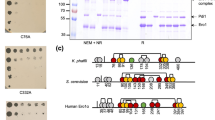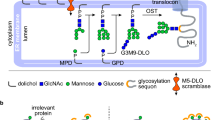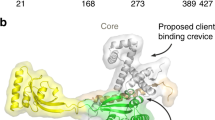Abstract
The formation of intra- and interchain disulphide bonds constitutes an integral part of the maturation of most secretory and membrane-bound proteins in the endoplasmic reticulum1,2. Evidence indicates that members of the protein disulphide isomerase (PDI) superfamily are part of the machinery needed for proper oxidation and isomerization of disulphide bonds3,4,5,6. Models based on in vitro studies predict that the formation of mixed disulphide bonds between oxidoreductase and substrate is intermediate in the generation of the native intrachain disulphide bond in the substrate polypeptide7. Whether this is how thiol oxidoreductases work inside the endoplasmic reticulum is not clear. Nor has it been established which of the many members of the PDI superfamily interacts directly with newly synthesized substrate proteins, because transient mixed disulphides have never been observed in the mammalian endoplasmic reticulum during oxidative protein folding7,8. Here we describe the mechanisms involved in co- and post-translational protein oxidation in vivo. We show that the endoplasmic-reticulum-resident oxidoreductases PDI and ERp57 are directly involved in disulphide oxidation and isomerization, and, together with the lectins calnexin and calreticulin, are central in glycoprotein folding in the endoplasmic reticulum of mammalian cells.
This is a preview of subscription content, access via your institution
Access options
Subscribe to this journal
Receive 51 print issues and online access
$199.00 per year
only $3.90 per issue
Buy this article
- Purchase on Springer Link
- Instant access to full article PDF
Prices may be subject to local taxes which are calculated during checkout





Similar content being viewed by others
References
Gething,M.-J. & Sambrook,J. Protein folding in the cell. Nature 355, 33–45 (1992).
Helenius,A., Marquardt,T. & Braakman,I. The endoplasmic reticulum as a protein folding compartment. Trends Cell Biol. 2, 227–231 (1992).
Freedman,R. B., Hirst,T. R. & Tuite,M. F. Protein disulphide isomerase: building bridges in protein folding. Trends Biochem. Sci. 19, 331–336 (1994).
Gilbert,H. F. Protein disulfide isomerase. Methods Enzymol. 290, 27–50 (1998).
Goldberger,R. F., Epstein,C. F. & Anfinsen,C. B. Acceleration of reactivation of reduced bovine pancreatic ribonuclease by a microsomal system of rat liver. J. Biol. Chem. 238, 628–635 (1963).
Weissman,J. S. & Kim,P. S. Efficient catalysis of disulphide bond rearrangements by protein disulphide isomerase. Nature 365, 185–188 (1993).
Huppa,J. B. & Ploegh,H. L. The eS-Sence of -SH in the ER. Cell 92, 145–148 (1998).
Ruddon,R. W. & Bedows,E. Assisted protein folding. J. Biol. Chem. 272, 3125–3128 (1997).
Braakman,I., Helenius,J. & Helenius,A. Role of ATP and disulphide bonds during protein folding in the endoplasmic reticulum. Nature 356, 260–262 (1992).
Krijnse-Locker,J. & Griffiths,G. An unconventional role for cytoplasmic disulfide bonds in Vaccinia virus proteins. J. Cell Biol. 144, 267–279 (1999).
Weissman,J. S. & Kim,P. S. Reexamination of the folding of BPTI: predominance of native intermediates. Science 253, 1386–1393 (1991).
Chen,W., Helenius,J., Braakman,I. & Helenius,A. Cotranslational folding and calnexin binding during glycoprotein synthesis. Proc. Natl Acad. Sci. USA 92, 6229–6233 (1995).
Sommer,A. & Traut,R. R. Diagonal polyacrylamide-dodecyl sulfate gel electrophoresis for the identification of ribosomal proteins crosslinked with methyl-4-mercaptobutyrimidate. Proc. Natl Acad. Sci. USA 71, 3946–3950 (1974).
Strauss,J. H. & Strauss,E. G. The alphaviruses: gene expression, replication, and evolution. Mocrobiol. Rev. 58, 491–562 (1994).
Garoff,H., Simons,K. & Dobberstein,B. Assembly of the Semliki Forest virus membrane glycoproteins in the membrane of the endoplasmic reticulum in vitro. J. Mol. Biol. 124, 587–600 (1978).
Marquardt,T. & Helenius,A. Misfolding and aggregation of newly synthesized proteins in the endoplasmic reticulum. J. Cell Biol. 117, 505–513 (1992).
Oliver,J. D., van der Wal,F. J., Bulleid,N. J. & High,S. Interaction of the thiol-dependent reductase ERp57 with nascent glycoproteins. Science 275, 86–88 (1997).
Oliver,J. D., Roderick,H. L., Llewellyn,D. H. & High,S. ERp57 functions as a subunit of specific complexes formed with the ER lectins calreticulin and calnexin. Mol. Biol. Cell. 10, 2573–2582 (1999).
Van Leeuwen,J. E. M. & Kearse,K. P. Deglucosylation of N-linked glycans is an important step in the dissociation of calreticulin-class I-TAP complexes. Proc. Natl Acad. Sci. USA 93, 13997–14001 (1996).
Acknowledgements
We thank T. Wileman, P. Van Nguyen and H. D. Söling for providing antibodies to ERp57 and PDI; L. Elgaard, C. Galli and A. V. Nicola for comments on the manuscript; and W. Chen and M. Corti for technical assistance. This work was supported by the ETHZ and by a Roche Foundation grant to M.M. and A.H.
Author information
Authors and Affiliations
Corresponding author
Supplementary information
Rights and permissions
About this article
Cite this article
Molinari, M., Helenius, A. Glycoproteins form mixed disulphides with oxidoreductases during folding in living cells. Nature 402, 90–93 (1999). https://doi.org/10.1038/47062
Received:
Accepted:
Issue Date:
DOI: https://doi.org/10.1038/47062
This article is cited by
-
Relevance of the endoplasmic reticulum-mitochondria axis in cancer diagnosis and therapy
Experimental & Molecular Medicine (2024)
-
TMX4-driven LINC complex disassembly and asymmetric autophagy of the nuclear envelope upon acute ER stress
Nature Communications (2023)
-
Differential expression of protein disulfide-isomerase A3 isoforms, PDIA3 and PDIA3N, in human prostate cancer cell lines representing different stages of prostate cancer
Molecular Biology Reports (2021)
-
Tailoring protein nanomechanics with chemical reactivity
Nature Communications (2017)
-
Expression and characterization of protein disulfide isomerase family proteins in bread wheat
BMC Plant Biology (2015)
Comments
By submitting a comment you agree to abide by our Terms and Community Guidelines. If you find something abusive or that does not comply with our terms or guidelines please flag it as inappropriate.



